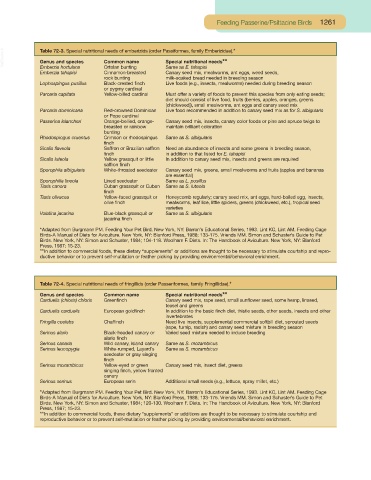Page 1211 - Small Animal Clinical Nutrition 5th Edition
P. 1211
Feeding Passerine/Psittacine Birds 1261
VetBooks.ir Table 72-3. Special nutritional needs of emberizids (order Passiformes, family Emberizidae).*
Special nutritional needs**
Common name
Genus and species
Emberzia hortulana
Cinnamon-breasted
Canary seed mix, mealworms, ant eggs, weed seeds,
Emberzia tahapisi Ortolan bunting Same as E. tahapisi
rock bunting milk-soaked bread needed in breeding season
Lophospingus pusillus Black-crested finch Live foods (e.g., insects, mealworms) needed during breeding season
or pygmy cardinal
Paroaria capitata Yellow-billed cardinal Must offer a variety of foods to prevent this species from only eating seeds;
diet should consist of live food, fruits (berries, apples, oranges, greens
[chickweed]), small mealworms, ant eggs and canary seed mix
Paroaria dominicana Red-crowned Dominican Live food recommended in addition to canary seed mix as for S. albigularis
or Pope cardinal
Passerina lelancheri Orange-bellied, orange- Canary seed mix, insects, canary color foods or pine and spruce twigs to
breasted or rainbow maintain brilliant coloration
bunting
Rhodospingus cruentus Crimson or rhodospingus Same as S. albigularis
finch
Sicalis flaveola Saffron or Brazilian saffron Need an abundance of insects and some greens in breeding season,
finch in addition to that listed for E. tahapisi
Sicalis luteola Yellow grassquit or little In addition to canary seed mix, insects and greens are required
saffron finch
Sporophila albigularis White-throated seedeater Canary seed mix, greens, small mealworms and fruits (apples and bananas
are essential)
Sporophilia lineola Lined seedeater Same as L. pusillus
Tiaris canora Cuban grassquit or Cuban Same as S. luteola
finch
Tiaris olivacea Yellow-faced grassquit or Honeycomb regularly; canary seed mix, ant eggs, hard-boiled egg, insects,
olive finch mealworms, leaf lice, little spiders, greens (chickweed, etc.), tropical seed
varieties
Volatina jacarina Blue-black grassquit or Same as S. albigularis
jacarina finch
*Adapted from Burgmann PM. Feeding Your Pet Bird. New York, NY: Barron’s Educational Series, 1993. Lint KC, Lint AM. Feeding Cage
Birds-A Manual of Diets for Aviculture. New York, NY: Blanford Press, 1988; 133-175. Vriends MM. Simon and Schuster’s Guide to Pet
Birds. New York, NY: Simon and Schuster, 1984; 104-118. Woolham F. Diets. In: The Handbook of Aviculture. New York, NY: Blanford
Press, 1987; 15-23.
**In addition to commercial foods, these dietary “supplements” or additions are thought to be necessary to stimulate courtship and repro-
ductive behavior or to prevent self-mutilation or feather picking by providing environmental/behavioral enrichment.
Table 72-4. Special nutritional needs of fringillids (order Passeriformes, family Fringillidae).*
Genus and species Common name Special nutritional needs**
Carduelis (chloris) chloris Greenfinch Canary seed mix, rape seed, small sunflower seed, some hemp, linseed,
teasel and greens
Carduelis carduelis European goldfinch In addition to the basic finch diet, thistle seeds, other seeds, insects and other
invertebrates
Fringilla coelebs Chaffinch Need live insects, supplemental commercial softbill diet, sprouted seeds
(rape, turnip, radish) and canary seed mixture in breeding season
Serinus alario Black-headed canary or Varied seed mixture needed to induce breeding
alario finch
Serinus canaria Wild canary, island canary Same as S. mozambicus
Serinus leucopygia White-rumped, Layard’s Same as S. mozambicus
seedeater or gray singing
finch
Serinus mozambicus Yellow-eyed or green Canary seed mix, insect diet, greens
singing finch, yellow fronted
canary
Serinus serinus European serin Additional small seeds (e.g., lettuce, spray millet, etc.)
*Adapted from Burgmann PM. Feeding Your Pet Bird. New York, NY: Barron’s Educational Series, 1993. Lint KC, Lint AM. Feeding Cage
Birds-A Manual of Diets for Aviculture. New York, NY: Blanford Press, 1988; 133-175. Vriends MM. Simon and Schuster’s Guide to Pet
Birds. New York, NY: Simon and Schuster, 1984; 120-130. Woolham F. Diets. In: The Handbook of Aviculture. New York, NY: Blanford
Press, 1987; 15-23.
**In addition to commercial foods, these dietary “supplements” or additions are thought to be necessary to stimulate courtship and
reproductive behavior or to prevent self-mutilation or feather picking by providing environmental/behavioral enrichment.

